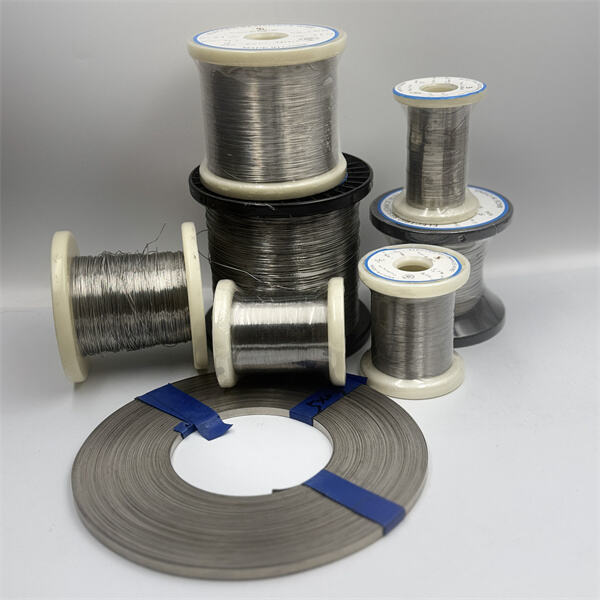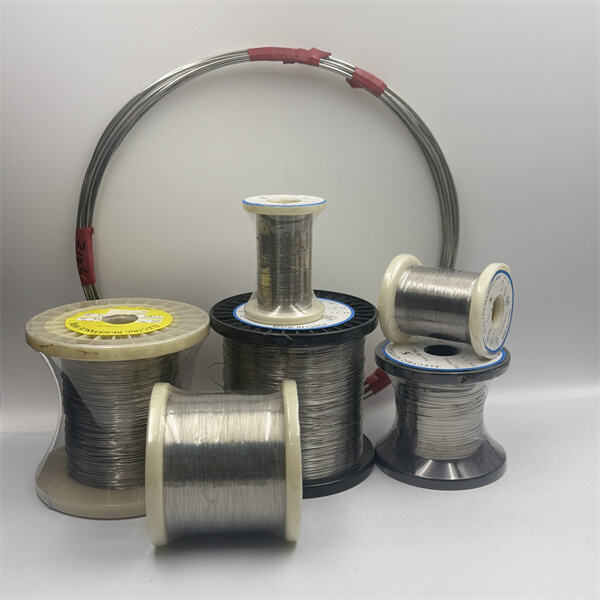Làm dây cáp kết nối thế giới.
Trong trường hợp bạn chưa quan tâm đến vấn đề này, nhưng bạn có bao giờ nghĩ về cách dây điện hoạt động không? Bạn là một phần quan trọng trong cuộc sống hàng ngày của chúng ta. Hãy cùng tìm hiểu xem có bao nhiêu điện có thể đi qua một sợi dây. Điều này rất quan trọng để đảm bảo các thiết bị điện hoạt động đúng cách. Kiến thức này giúp chúng ta an toàn và hiệu quả hơn trong việc sử dụng điện. Thôi nào, hãy cùng bước vào thế giới của dây điện.
Trước tiên, chúng ta cần hiểu ý nghĩa của từ 'điện trở' trước khi có thể học cách đo dòng điện. Điện trở là một từ dùng để chỉ mức độ khó khăn khi làm cho điện di chuyển qua dây dẫn. Nó giống như việc cố gắng đi qua một căn phòng đầy người — càng có nhiều người (hoặc vật cản), càng khó để đi qua. Dây điện trở bởi TS Heating Alloy phụ thuộc vào ba yếu tố: chiều dài của dây, độ dày của dây và chất liệu cấu thành.
Càng dài dây dẫn thì thường càng khó cho dòng điện đi qua. Hãy tưởng tượng việc cố gắng đẩy một quả bóng qua một ống dài một cách mượt mà, nên bạn cần nhiều sức hơn. Dòng điện cũng có thể đi qua các dây dẫn nhỏ hơn; tuy nhiên, khả năng làm được điều đó lại giảm. Giống như khi bạn cố hút một ly sữa lắc đặc qua một ống hút nhỏ xíu — nó không hoạt động tốt! Hơn nữa, một số vật liệu chống lại dòng chảy của điện nhiều hơn những vật liệu khác. Ví dụ, cao su là chất dẫn điện kém, trong khi các kim loại như đồng là chất dẫn điện tốt.
Sau đó, chúng tôi sẽ nối dây vào nguồn điện và đặt điện áp ở một mức nhất định. Điện áp giống như lực đẩy cho phép dòng điện lưu thông qua dây TS Heating Alloy. Sau đó, chúng tôi sẽ sử dụng ampe kế để đo cường độ dòng điện đang chảy qua dây tại thời điểm đó. Điều này giống như đo tốc độ dòng chảy của một con sông. Cuối cùng, chúng tôi sẽ dùng vôn kế để đo điện áp trên dây. Điều này giúp chúng tôi xác định mức độ mạnh của lực đẩy điện.

Dây dẫn mỏng hơn cũng có điện trở cao hơn. Giống như việc cố gắng đi qua một cánh cửa hẹp, bạn sẽ cần một cánh cửa lớn hơn. Dây Ni-Cr vật liệu cũng là một yếu tố quan trọng không kém. Một ví dụ điển hình là đồng: nó cho phép dòng điện lưu thông qua nó khá tốt, vì vậy nó được sử dụng rất phổ biến trong các hộ gia đình làm dây điện. Mặt khác, một số vật liệu thực sự rất kém trong việc cho phép dòng điện lưu thông qua chúng, như sắt.

Để đo điện trở của dây dẫn một cách chính xác, chúng ta cần thực hiện một số phép đo rất chính xác. Để xác định các thông số của dây dẫn, trước tiên chúng ta cần đo chiều dài và độ xoắn đúng cách. Điều này quan trọng vì ngay cả những biến thiên nhỏ cũng có thể ảnh hưởng đến cách dòng điện di chuyển. Chúng ta cũng cần duy trì dây dẫn ở một nhiệt độ cụ thể vì nhiệt độ cũng có thể thay đổi điện trở. Khi dây dẫn nóng lên quá mức, điện trở của chúng có thể tăng lên, và điều đó có thể gây ra vấn đề.

Tương tự như ngành công nghiệp dầu mỏ, càng tìm hiểu về cách đo điện trở, bạn càng nói: "Này, chúng ta đang tạo ra sự khác biệt ở đây" và thật tuyệt khi chúng ta làm được điều đó. Chúng ta biết rằng đồng thường được sử dụng để làm dây trong các thiết bị điện của chúng ta vì nó có điện trở thấp. Các tạp chất trong kim loại khiến dòng điện khó lưu thông, do đó dây đồng rất dẫn điện và hiệu quả. Dây cáp dây làm từ nhôm cũng có thể sử dụng được, nhưng có điện trở cao hơn. Điều này có nghĩa là nó không được sử dụng phổ biến cho dây điện như đồng.
Với hàng chục loại vật liệu có sẵn, TS Heating Alloy Materials Co., Ltd cung cấp một phạm vi rộng các sản phẩm dây điện trở và cáp thép. Sự đa dạng này đảm bảo rằng chúng tôi đáp ứng được các nhu cầu cụ thể của nhiều ngành công nghiệp khác nhau, từ xây dựng đến các lĩnh vực chuyên biệt yêu cầu dây cáp điện trở. Khả năng cung cấp cả giải pháp tiêu chuẩn và theo đặt hàng khiến chúng tôi trở thành điểm đến duy nhất cho các doanh nghiệp trên toàn thế giới, mang lại tính linh hoạt và khả năng thích ứng với các nhu cầu thị trường khác nhau.
Kể từ khi thành lập vào năm 2023, Công ty TNHH Vật liệu Hợp kim Luyện kim TS đã mở rộng dấu chân quốc tế thông qua các đối tác thương mại mạnh mẽ. Sản phẩm của chúng tôi hiện đã được xuất khẩu thành công đến các khu vực như Nhật Bản, Hàn Quốc, Đông Nam Á, châu Âu và châu Phi, với trọng tâm là xây dựng các mối quan hệ lâu dài. Bằng cách tiếp tục phát triển thương hiệu Hợp kim Luyện kim TS trên toàn cầu, chúng tôi hướng tới việc tăng cường sự công nhận và mở rộng sự hiện diện trên các thị trường quốc tế, cung cấp vật liệu hợp kim hiệu suất cao cho khách hàng trên toàn thế giới. Bốn điểm nổi bật này thể hiện những thế mạnh của Công ty TNHH Vật liệu Hợp kim Luyện kim TS, cho thấy cam kết về chất lượng, dịch vụ khách hàng và mở rộng toàn cầu của công ty.
Tọa lạc tại Thái Châu, Giang Tô, Trung Quốc, Công ty TNHH Vật liệu Hợp kim Sưởi ấm TS受益 từ vị trí gần Cảng Thượng Hải, một trong những trung tâm vận tải biển bận rộn nhất thế giới. Vị trí chiến lược này giúp việc vận chuyển quốc tế được hiệu quả, cho phép chúng tôi cung cấp dịch vụ giao hàng kịp thời đến các thị trường trên khắp châu Á, châu Âu, Bắc Mỹ và châu Phi. Khả năng logistics của chúng tôi đảm bảo rằng chúng tôi có thể đáp ứng nhu cầu toàn cầu nhanh chóng và đáng tin cậy, làm cho chúng tôi trở thành đối tác lý tưởng cho các công ty đang tìm kiếm sản phẩm dây hợp kim chất lượng cao với thời gian hoàn thành nhanh.
Công ty TNHH Vật Liệu Hợp Kim Nhiệt TS được trang bị công nghệ tiên tiến, bao gồm máy kéo dây, lò nhiệt luyện và máy đóng gói. Điều này đảm bảo rằng mọi sản phẩm, từ nguyên liệu thô đến sản phẩm hoàn thiện, đều đáp ứng các tiêu chuẩn chất lượng nghiêm ngặt. Các quy trình sản xuất của công ty được thiết kế để đạt độ chính xác và tin cậy cao, cho phép sản xuất các dây điện trở chất lượng cao và cáp thép. Dù là dây Fe-Cr-Al hay Ni-Cr, các sản phẩm của chúng tôi đều được chế tạo với sự chăm sóc và chuyên môn, đảm bảo hiệu suất tối ưu trong nhiều ứng dụng công nghiệp khác nhau.